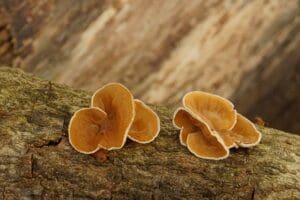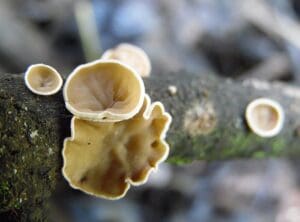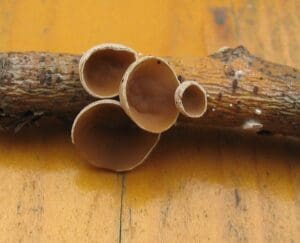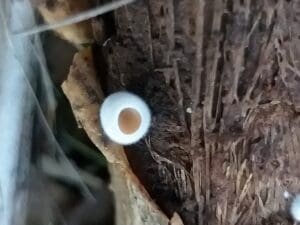Poplar Bell Fungus / Autumn / Inedible
There’s something truly special about stumbling across a rare find in the woods—one of those moments when you feel like you’ve uncovered a hidden treasure. That’s exactly how I felt the first time I spotted the Schizophyllum amplum, better known as the poplar bell fungus.
This curious little fungus is a rare treat to find in the UK, typically gracing the deadwood of poplars and willows with its delicate, bell-like shape. It’s not something you come across every day, which makes identifying it all the more rewarding.
Most commonly confused for the jelly ear mushroom
Scientific Name
Schizophyllum amplum
Common Name
Popular bell
Family
Schizophyllaceae
Habitat and season
Can be found on fallen branches of popular and less so willow. Also likes to grow on thin branches high up on the tree.
September to November
Identifying Features of Poplar bell fungus
A cup shaped gelatinous fungi hanging from dead wood usually in clusters. Its jelly-like flesh is very tolerant of drying out. Reaching about 1-2 cm in size, although small overall this is on the larger side for its family.

Flesh
Tough, gelatinous

Cap/upper side
White and felty, slightly veined. sometime slightly wavy/ irregular

Fertile side
No gills, a gell-like smooth surface becoming radically wrinkled, mid brown/ tan.

Stem
No stem, tapers in slightly where it attaches to the wood.
Smell:
Not distinctive
no taste
Spores
white
Uses of the Poplar bell fungus
Inedible, tough
Conservation Considerations
Uncommon to rare , best left in the interest of conservation.
The Polar Bell Fungus Could Be Confused With…
Would be hard to confuse with any other fungi when both the cap and under-side are compared.
The split gil schizophyllum commune- which has a hairier cap and gills
The edible wood ear Auricularia auricula-judae which is a mid brown on both sides
Peziza- is a large family of cup shaped fungus. They have a firmer texture and the cap and inner cup are very similar in colour.
Caution and known hazards
None known
Resources
https://www.fungalpunknature.co.uk/Fungi/Schizophyllum%20amplum.html
Fungi of temperate Europe vol 2 by Thomas Laesson and Jens H.Peterson
https://en.wikipedia.org/wiki/Schizophyllum_amplum





